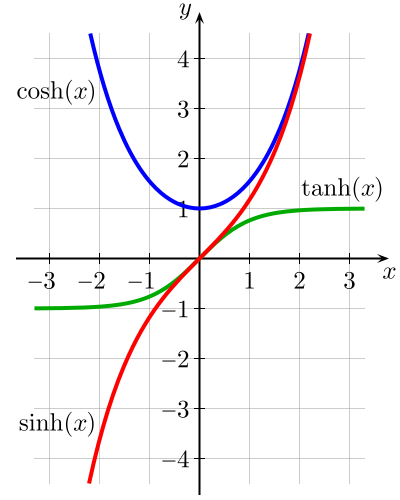Deine Meinung zählt – Gestalte unsere Lerninhalte mit!
Wir entwickeln neue, interaktive Formate für die Hochschulmathematik. Nimm dir maximal 15 Minuten Zeit, um an unserer Umfrage teilzunehmen.
Mit deinem Feedback machen wir die Mathematik für dich und andere Studierende leichter zugänglich!
Dieser Abschnitt ist noch im Entstehen und noch nicht offizieller Bestandteil des Buchs. Gib den Autoren Zeit, den Inhalt anzupassen!
 Die Hyperbolischen Funktionen - Kosinus Hyperbolikus, Sinus Hyperbolikus und Tangens Hyperbolikus
Die Hyperbolischen Funktionen - Kosinus Hyperbolikus, Sinus Hyperbolikus und Tangens Hyperbolikus
Definition von Sinus Hyperbolicus und Kosinus Hyperbolicus
[Bearbeiten]
Definition (Sinus Hyperbolicus und Kosinus Hyperbolicus)
Wir definieren die Funktionen  (Sinus Hyperbolicus) und
(Sinus Hyperbolicus) und  (Kosinus Hyperbolicus) durch
(Kosinus Hyperbolicus) durch
![{\displaystyle {\begin{aligned}&\sinh :\mathbb {R} \to \mathbb {R} ,x\mapsto {\frac {1}{2}}(e^{x}-e^{-x})\\[0.3em]&\cosh :\mathbb {R} \to \mathbb {R} ,x\mapsto {\frac {1}{2}}(e^{x}+e^{-x})\end{aligned}}}](https://wikimedia.org/api/rest_v1/media/math/render/svg/331de5fed31a53beee8a703134465b85d1d7bb69)
Hinweis
Als Merkhilfe für das Vorzeichen: Sinus und Minus reimt sich.
Eigenschaften der Hyperbolischen Funktionen
[Bearbeiten]Der Kosinus Hyperbolicus ist symmetrisch zur y-Achse, während Sinus und Tangens Hyperbolicus punktsymmetrisch zum Ursprung sind. Es gilt also:

Man sagt auch  ist eine gerade Funktion, die anderen beiden sind ungerade.
ist eine gerade Funktion, die anderen beiden sind ungerade.
Wir wollen die eben genannten Eigenschaften beweisen:
Beweis

Mit der Definition über die Exponentialfunktion können wir die Ableitungen der Hyperbolischen Funktionen bestimmen.

Der Beweis für diese Gleichungen ist im Kapitel Beispiele für Ableitungen zu finden.
Beziehung zwischen den Hyperbolischen Funktionen
[Bearbeiten]Analog zu den Trigonometrischen Funktionen, haben wir eine Beziehung zwischen den Quadraten von  und
und  . Der Unterschied liegt im Vorzeichen.
. Der Unterschied liegt im Vorzeichen.

Beweis
![{\displaystyle {\begin{aligned}\cosh(x)^{2}-\sinh(x)^{2}&=\left({\frac {e^{x}+e^{-x}}{2}}\right)^{2}-\left({\frac {e^{x}-e^{-x}}{2}}\right)^{2}\\&={\frac {1}{4}}\left[\left(e^{2x}+e^{-2x}+2e^{x}e^{-x}\right)-\left(e^{2x}+e^{-2x}-2e^{x}e^{-x}\right)\right]\\&{\color {OliveGreen}\left\downarrow \ e^{x}e^{-x}=1\right.}\\&={\frac {1}{4}}\cdot 4=1\end{aligned}}}](https://wikimedia.org/api/rest_v1/media/math/render/svg/2784164a88a59e31e3d5b53a90ef21d1aa6b01a3)
Im Grenzwert  divergieren
divergieren  und
und  . Um zu bestimmen ob der Grenzwert
. Um zu bestimmen ob der Grenzwert  oder
oder  ist, setzen wir die Definition durch die Exponentialfunktion.
ist, setzen wir die Definition durch die Exponentialfunktion.

Da  und
und  bedeutet das, dass Sinus und Kosinus als Funktionen komplexer Argumente nicht beschränkt sind.
bedeutet das, dass Sinus und Kosinus als Funktionen komplexer Argumente nicht beschränkt sind.

Der Beweis funktioniert völlig analog zu den Trigonometrischen Additionstheoremen.






![{\displaystyle {\begin{aligned}&\sinh :\mathbb {R} \to \mathbb {R} ,x\mapsto {\frac {1}{2}}(e^{x}-e^{-x})\\[0.3em]&\cosh :\mathbb {R} \to \mathbb {R} ,x\mapsto {\frac {1}{2}}(e^{x}+e^{-x})\end{aligned}}}](https://wikimedia.org/api/rest_v1/media/math/render/svg/331de5fed31a53beee8a703134465b85d1d7bb69)






![{\displaystyle {\begin{aligned}\cosh(x)^{2}-\sinh(x)^{2}&=\left({\frac {e^{x}+e^{-x}}{2}}\right)^{2}-\left({\frac {e^{x}-e^{-x}}{2}}\right)^{2}\\&={\frac {1}{4}}\left[\left(e^{2x}+e^{-2x}+2e^{x}e^{-x}\right)-\left(e^{2x}+e^{-2x}-2e^{x}e^{-x}\right)\right]\\&{\color {OliveGreen}\left\downarrow \ e^{x}e^{-x}=1\right.}\\&={\frac {1}{4}}\cdot 4=1\end{aligned}}}](https://wikimedia.org/api/rest_v1/media/math/render/svg/2784164a88a59e31e3d5b53a90ef21d1aa6b01a3)







